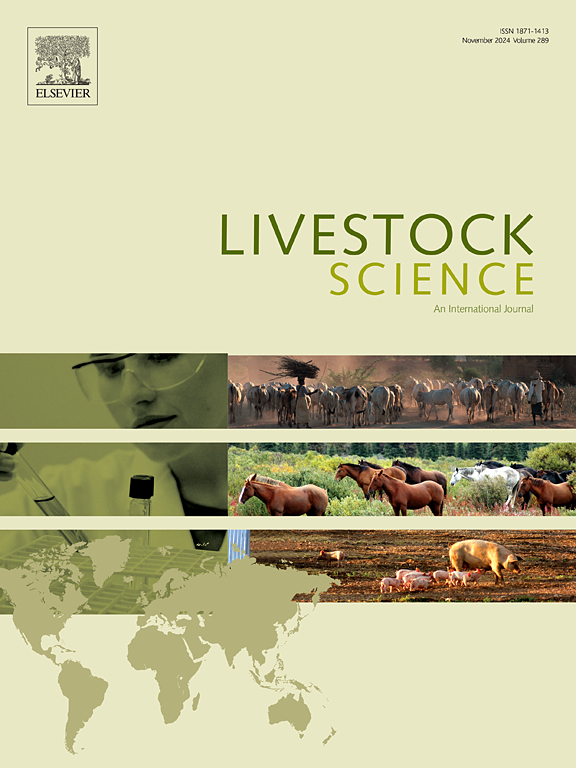Variability in major milk protein genes in two autochthonous cattle breeds mainly reared in the Parmigiano-Reggiano cheese production area: Reggiana and Modenese
IF 1.8
3区 农林科学
Q2 AGRICULTURE, DAIRY & ANIMAL SCIENCE
引用次数: 0
Abstract
Reggiana and Modenese (also known as Bianca Valpadana) are two iconic autochthonous cattle breeds mainly raised in the North of Italy, in the area where the Protected Designation of Origin Parmigiano-Reggiano cheese is produced. The monitoring of diffusion of milk protein gene variants in these cattle breeds is important to evaluate the impact of selection and conservation programs on the frequency of favourable alleles on milk quality and cheese-making properties and to avoid the increase of the frequency of alleles with unfavourable effects. In this study, we genotyped a total of ∼3,300 cattle of the Reggiana and Modenese breeds with the GeneSeek® Genomic Profiler™ Bovine 150 K Array and obtained an updated picture of the variability present in three milk protein genes (CSN2, CSN3 and PAEP, also known as β-lactoglobulin). We then retrospectively evaluated the trend of allele frequency changes over time, going back ∼50 years, comparing the information reported by previous studies in the same two breeds. The allele frequency trends could be considered either positive, according to the increase in frequency of alleles with favorable effects on cheese making properties and cheese yield (i.e., CSN3*B in both breeds) or negative, based on the decrease in frequency of favorable alleles on the same traits (i.e., PAEP*B in Reggiana). Therefore, some adjustments in the selection and conservation programs might be needed to maintain genetic properties that can positively contribute to addressing the production of high-quality Parmigiano-Reggiano cheese and support a sustainable conservation of these cattle genetic resources.
主要在 Parmigianoo-Reggiano 奶酪产区饲养的两个本地牛种的主要牛奶蛋白基因的变异性:Reggiana 和 Modenese
Reggiana 和 Modenese(又称 Bianca Valpadana)是两个标志性的本地牛种,主要在意大利北部饲养,该地区是生产原产地名称受保护的 Parmigianoo-Reggiano 奶酪的地方。监测牛奶蛋白基因变异在这些牛种中的扩散情况,对于评估选择和保护计划对牛奶质量和奶酪制作特性有利等位基因频率的影响以及避免不利等位基因频率的增加非常重要。在这项研究中,我们使用 GeneSeek® Genomic Profiler™ Bovine 150 K 阵列对 Reggiana 和 Modenese 品种的 3300 头牛进行了基因分型,并获得了三个牛奶蛋白基因(CSN2、CSN3 和 PAEP,又称 β-乳球蛋白)的最新变异情况。然后,我们回顾性地评估了等位基因频率随时间推移而变化的趋势(可追溯至 50 年前),并比较了以前对相同两个品种的研究报告信息。等位基因频率的变化趋势可以被认为是积极的,因为对奶酪制作特性和奶酪产量有有利影响的等位基因频率增加了(如两个品种中的 CSN3*B);也可以被认为是消极的,因为对相同性状有利的等位基因频率减少了(如 Reggiana 的 PAEP*B)。因此,可能需要对选育和保护计划进行一些调整,以保持能积极促进优质 Parmigiano-Reggiano 奶酪生产的遗传特性,并支持这些牛遗传资源的可持续保护。
本文章由计算机程序翻译,如有差异,请以英文原文为准。
求助全文
约1分钟内获得全文
求助全文
来源期刊

Livestock Science
农林科学-奶制品与动物科学
CiteScore
4.30
自引率
5.60%
发文量
237
审稿时长
3 months
期刊介绍:
Livestock Science promotes the sound development of the livestock sector by publishing original, peer-reviewed research and review articles covering all aspects of this broad field. The journal welcomes submissions on the avant-garde areas of animal genetics, breeding, growth, reproduction, nutrition, physiology, and behaviour in addition to genetic resources, welfare, ethics, health, management and production systems. The high-quality content of this journal reflects the truly international nature of this broad area of research.
 求助内容:
求助内容: 应助结果提醒方式:
应助结果提醒方式:


